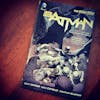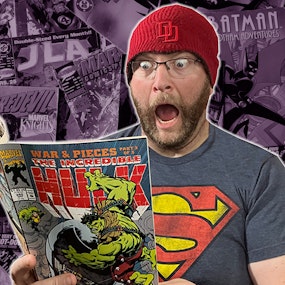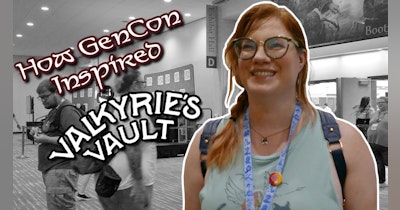COMIC BIBLIOGRAPHY
Title: Batman Volume 1: The Court of Owls
Writer: Scott Snyder
Penciler: Greg Capullo
Inker: Jonathan Glapion
Publisher: DC Comics
Release Year: 2011-2012

REVIEW
Batman had heard the tales of Gotham City's Court of Owls. Meeting in the shadows and using the nocturnal bird of prey as their calling card, the members of this powerful cabal are the true rulers of Gotham. But the Dark Knight dismissed the stories as rumors and old wives' tales. Gotham was his city.
Until now.
A brutal assassin is sinking his razor-sharp talons into the city's best and brightest, as well as its most dangerous and deadly. If the dark legends are true, his masters are more powerful predators than Batman could ever imagine - and their nests are everywhere...
-Description from the inside cover
When I posted a question on Reddit asking what would be the best Batman comic to read, this one came up a few times. One user said that it also introduces us to the Bat-family, which caught my interest immediately because I never really read about the other members of the Bat-family. So I decided to give this comic story a shot. After reading this, it has now not only become one of my favorite comics of all time, but this will be the comic I will always suggest if someone asks for a recommendation for someone that is a first-time comic reader or to someone skeptical of comics as a medium.
THE WRITING
This book is far different from any comic I've read growing up, and for a lot of reasons. Snyder's writing was superb from the get-go. In the first few pages, we get a sense of the type of Batman/Bruce Wayne that we are going to journey with; serious, cocky, cunning, humorous, veteran vigilante who is going about his work as though it is another day on the job (even after putting the beat down on a gang of archenemies inside Arkham Asylum). So when a murder seems to reveal an ancient legend of the "Court of Owls" and their assassin, Talon, is on the loose in Gotham, Batman dismisses all of this (and for good reason, which I won't spoil). After all, this is his city, and he knows his city best. To admit that a historic, secret group of villains is controlling the city under his nose would imply that he doesn't know anything about his city, and that can't be true. Right?
What I love about Snyder's writing here is that it highlights some of the Dark Knight's humor that we don't get to see in other comics or movies. What's great about the humor in the comic is that it is still befitting his character that doesn't overshadow or rewrite what we know and loves about Batman. It is the kind of sarcastic, smart-aleck humor that fits the character very well and still makes you laugh out loud and enjoy the moment. Snyder also does a phenomenal job of using secondary characters to help tell the story and add to the narration and the story, instead of relying solely on the inner thoughts of Batman (for example, using Harvey Bullock's dialogue with Batman to set up the first major mystery of the book to show how you and Batman do not know Gotham the way you think you do). Overall, the writing here keeps you hooked at every turn and it was just impossible for me to put down (the only reason why I did was that my son wanted to play. Darn kids.)
There is one criticism I have about the writing, but before I expand on that, I do have to admit that this is the only book of the story arc I've read so far. So it could be that my criticism is limited because it may get addressed in the following series, which would then make this criticism (somewhat) null and void.
In reading the story, I have to say that I was a little disappointed that we didn't get to see more of the characters that were introduced. For example, in the first chapter, we get to see Dick Grayson, Tim Drake, and Damian Wayne dressing up for the gala. It was genius how we get introduced as well; Bruce Wayne is testing a new contact-based technology that uses facial recognition and wireless connection to the Bat computer to tell us who each person is, their alias, and what level of clearance they have. However, after this moment, we don't see very much of the contact technology get used (which I think is a shame) and Tim Drake & Damian Wayne are virtually nonexistent, which makes me wonder why to introduce them this way, to begin with.
We also get introduced to Lincoln March as well. He does have a bigger role as a small part, and again, perhaps his role will develop more in later books. But as of right now, I'm left wondering why he seems like he has such an important role at the beginning, only to leave him out of the rest of the story early on after an incident with the Court of Owls. I still think his role is going to be revealed more later on, but if I was going by just this book, it's a complete mystery to me.
And lastly, probably the one thing that I probably won't get over, is the introduction to a character named Harper. Late in the story, we see an interaction between Batman and Harper (again, I won't spoil the situation). But this interaction is the only time we see Harper in the entire story.; a full two-page, 10 panels, 17 sentences. And the way Batman reacts and talks to Harper makes it seem like he's met her before, doesn't want anything to do with her, and the reader has no idea why. Even if this is explained later in the other story arcs, this still confounds me and makes me wish that this was contextualized a little more for the readers who are reading this story in this series without any prior knowledge for the first time.
But again, it deserves mentioning that even with these minute disturbances I had with the writing, the fact that this is my current gold standard for comic books should still tell you something about his writing; that it is unparalleled with any other Batman story, and that it should be considered a must-have for any Batman and comics fan.
THE ARTWORK
As superb as the writing is, any great comic needs to be supported by the artwork, and Capullo & Glapion nails it. They can capture any moment, emotion, and story through their art, drawing us in with every panel, telling the story in such a vivid and diverse way that it never leaves us lost or stale. Although there are many things I can say about their artwork, the three main components of their work I want to highlight are their use of composition, negative space/color, and coloring.
As a video creator, I absolutely love their use of composition and framing in this book. There were multiple times where they intentionally planned their pages as a whole and utilized the numerous panels to create great compositions that paint a picture beyond just the story being told at the moment. For example, they used two panels aligned on top of each other to show the back and top-half of the Batman cowl at the bottom of the panel to sit on top of Bullock's front and lower face in the top of the panel underneath it to create a flow that depicts Batman being part of the story in more ways than one. Another example is how they use the juxtaposition to highlight the dualistic nature of the city through the lights and shadows of Batman. On the left page, you see the shadow of the Batman, where you still see some color but most of his defining features are still left in the shadow. Then on the page on the right, you see Batman in the sewers with a light, now illuminating him, which serves as a metaphor for him exploring the city for the first time. Truly a great way to use art to tell a story on its own as a framing story inside the main storyline.
Capullo and Glapion were also champions in using negative space to their advantage. It wasn't used in most of the story; maybe about a third of the comic at best. But when it was used, it was done effectively to utilize abstract and minimal art to give multiple meanings to the story being told, either to let the reader use their imagination or to help highlight what to really pay attention to. This also helps enhance the intensity factor of the main antagonist, Talon, who is, like our protagonist, wears an outfit that resembles what he represents (the owl). His pale yellow eyes have a flat, albeit sharp look that instills fear in those around him (and the reader), and this is done by isolating the eyes with removing details in the panel. And this is just one of many examples.
As I mentioned earlier, the coloring that they use also plays a huge part in the story as well. Much of the colors in the story are flat, which serves as a metaphor for what we know about Gotham. Much like the colors, what we think we know about Gotham is mediocre and somewhat unnoticeable. But as we go through moments where Batman finds out more about his city and where the Court of Owls are involved, the color tends to pop out more than what it looked like previously. Especially when we see blood - the colors used give it a very glossy look, which goes on the opposite spectrum of the flat that we see in the artwork throughout the story.
FINAL THOUGHTS (AND SPOILER AHEAD!)
To forewarn you, I will be revealing a possible spoiler for you about this comic. So if you want to remain spoiler-free, I recommend you stop now, go read the comic, then come back to finish reading this review to see the rest.
Last chance...
As you can tell up to this point, I absolutely love this comic. Snyder did a fantastic job of writing the story, and Capullo & Glapion should claim this as one of their masterpieces. But one of the defining elements of this story that we should all take with us is the chapter where Batman is caught in the Court of Owls' maze. This team was able to think outside the box here and have us interact with the comic in a way that we've never seen done in most comic books. To emphasize how Batman's life and point of view were literally being turned around in more ways than one, the team designed the pages so that you had to flip the book on its side, then upside down, to keep reading. This was a simple yet elegant and brilliant way for the reader to experience that change and unsettling feeling that Batman was going through. I seriously felt like I was part of that story, that I was physically inside the mind of Batman at that moment as he was struggling and trying to make sense of what was happening to him, trying to fight and win while at the same time doubting the reality he was living in. This will go down as one of the defining moments for this storyline and the brilliance of this story in creating a masterpiece by taking advantage of all of the elements of the medium that comprises a comic book.
All in all, this story arc will be the new golden standard that future generations of comic writers and artists will point to when they try to describe creating a story "as good as". Because this will be one of the hardest comics to out-write, out-draw, out-color, and out-design to ever replace it (if it happens at all). So if you haven't read it, go out to your local comic book shop or library and get this. If you have read it but don't own it, you should. This one should be readily available to anyone that enters our home and wants to learn more about why anyone at any age should care for and love comics.

















